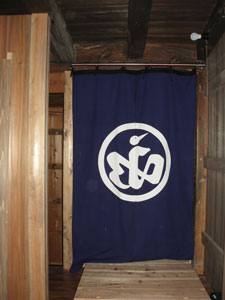
June: 揚げ幕
(agemaku)
Maku are a vital part of Kabuki production. A number of different kinds of curtains, or maku, are used, including the traveler show curtain (joshiki maku or hiki maku), the drop curtain (doncho), the kuro maku (black curtain), and the anten maku (blackout curtain).
The Agemaku is a curtain hung at the rear end of the hanamichi and occasionally at the entrance on stage left. It is a dark blue cloth on which the theater’s crest is painted in white. The curtain hangs from metal rings and, as it is swished open to the left or right, makes a distinctive sound signaling to the audience that someone is about to enter. The room at the end of the hanamichi is called the koya, the agemaku, or the toya, and it provides access to and from the backstage area via a passageway (naraku) under the theater. Actors wait in this room to make their entrance on the hanamichi. The toyaban (also agemakuban and kirimaku) opens and closes the curtain for the entering and exiting actors. The hanamichi agemaku curtain is similar to that on the Noh Theater Bridgeway (hashigakari), though the Noh curtain is of five colors and opens and closes by being raised and lowered by a bamboo pole. However, the scenery for Kabuki plays adapted from the Noh uses the same kind of agemaku as the Noh, placing it diagonally on the upstage right wall.
References
KABUKI ENCYCLOPEDIA by SAMUEL L. LEITER
Read - WP customer service guide by Geometricbox
